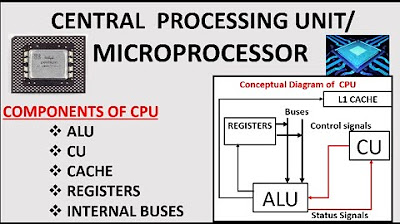Address, Data and Control Buses
Summary
TLDRThis video script explains the concept of computer buses, focusing on the CPU and main memory connection. It discusses the role of buses in data transmission, their speed measured in megahertz, and bus width indicating data transfer capacity in bits. The script distinguishes between unidirectional and bi-directional buses, detailing the functions of address, data, and control buses. Address buses transmit memory addresses from CPU to RAM, data buses handle actual data transfer bidirectionally, and control buses carry commands and status messages. The script emphasizes the importance of bus width matching the computer's architecture, such as a 64-bit computer requiring a 64-bit wide bus.
Takeaways
- 💻 Main memory is directly accessible by the CPU without needing to go through secondary storage devices.
- 🚌 A computer bus is a collection of wires that transmit data, with speed measured in megahertz based on the clock.
- 🔢 The bus width, or size, indicates how many bits can be transferred at one time, which is crucial for the CPU's data handling capacity.
- 🔑 The address bus carries memory addresses from the CPU to memory, indicating where data is located for reading or writing.
- 📦 The data bus is bi-directional, transferring data between the CPU and RAM, and its width must match the computer's bit architecture.
- 📡 The control bus carries commands from the CPU to other devices and status messages back, and it can be smaller than the data bus.
- 🛣️ Buses can be either unidirectional, moving data in one direction, or bi-directional, allowing data to move both ways.
- 🔄 The address and data buses are used multiple times during the fetch-execute cycle of a CPU.
- ⏰ The clock signal, crucial for regulating the CPU, is sent via the control bus.
- ✋ Interrupts are a mechanism by which hardware can stop the CPU's current operations to execute something more urgent.
Q & A
What is the main function of a CPU?
-A CPU (Central Processing Unit) is the primary component of a computer that performs most of the processing inside the computer. It interprets and executes instructions from the computer's hardware and software.
What is the role of main memory in a computer system?
-Main memory, typically RAM (Random Access Memory), serves as the primary storage for a computer's operating system, applications, and data that are actively in use. It allows the CPU to access and manipulate data quickly.
How does a bus in a computer function?
-A computer bus is a collection of wires that allows data to be transmitted between different parts of the computer. It facilitates communication between the CPU, memory, and other peripherals.
What is the speed of a bus measured in?
-The speed of a bus is measured in megahertz (MHz), which is based on the clock that regulates the data transfers.
What is the significance of the bus width?
-The bus width, also known as the size of a bus, refers to the number of bits that can be transferred at one time. A wider bus can transfer more data simultaneously, improving the efficiency of data movement within the computer.
Why is the address bus unidirectional?
-The address bus is unidirectional because it only needs to send memory addresses from the CPU to the RAM, telling the RAM where to read from or write to. There's no need for the RAM to send addresses back to the CPU.
What is the purpose of the data bus?
-The data bus is bi-directional and is used to transfer actual data between the CPU and other devices such as RAM. It can carry data in both directions, allowing for the transfer of data to and from the CPU.
How does the control bus differ from the address and data buses?
-The control bus carries commands from the CPU to other devices and status messages back from those devices. It is bi-directional and can be used to send signals like clock signals, read/write commands, and interrupts.
Why is the control bus important for communication between the CPU and other hardware?
-The control bus is crucial for communication because it allows the CPU to send commands to other devices and receive signals that may require immediate attention, such as interrupts that can prevent system crashes.
What does the term 'clock signal' refer to in the context of a control bus?
-The clock signal is a timing signal sent along the control bus to the CPU. It is used to synchronize the operations of the CPU and regulate its speed.
How does the width of a computer's bus affect its performance?
-A wider bus can transfer more bits of data at a time, which can lead to faster data processing and improved overall system performance, especially in tasks that require large amounts of data to be moved quickly.
Outlines

This section is available to paid users only. Please upgrade to access this part.
Upgrade NowMindmap

This section is available to paid users only. Please upgrade to access this part.
Upgrade NowKeywords

This section is available to paid users only. Please upgrade to access this part.
Upgrade NowHighlights

This section is available to paid users only. Please upgrade to access this part.
Upgrade NowTranscripts

This section is available to paid users only. Please upgrade to access this part.
Upgrade NowBrowse More Related Video

L-1.3 Bus Structure | Type of Buses | Address Bus, Data Bus, Control Bus | CSA | COA |Shanu Kuttan

How do computers work? CPU, ROM, RAM, address bus, data bus, control bus, address decoding.

Computer Buses

Computer System Operation in Operating system || Computer System Organization || Operating System

CPU and Its Components|| Components of MIcroprocessor

1. OCR A Level (H046-H446) SLR1 - 1.1 ALU, CU, registers and buses
5.0 / 5 (0 votes)